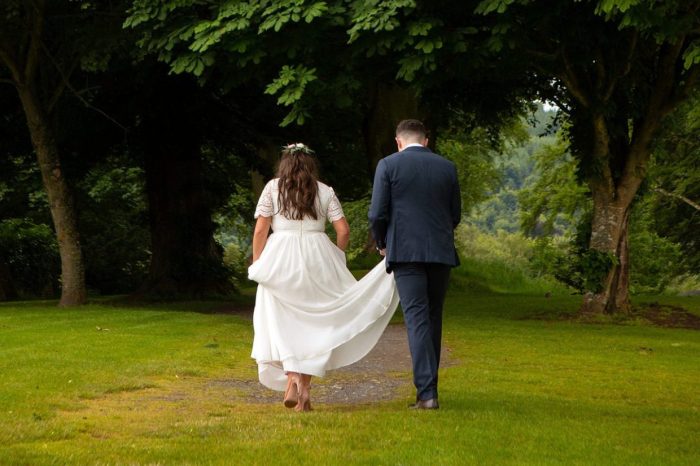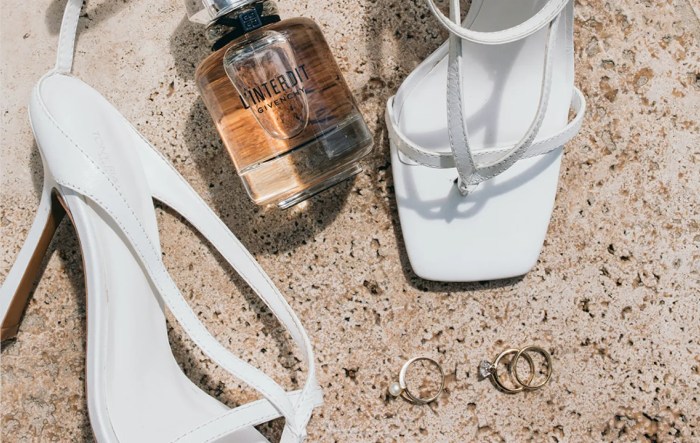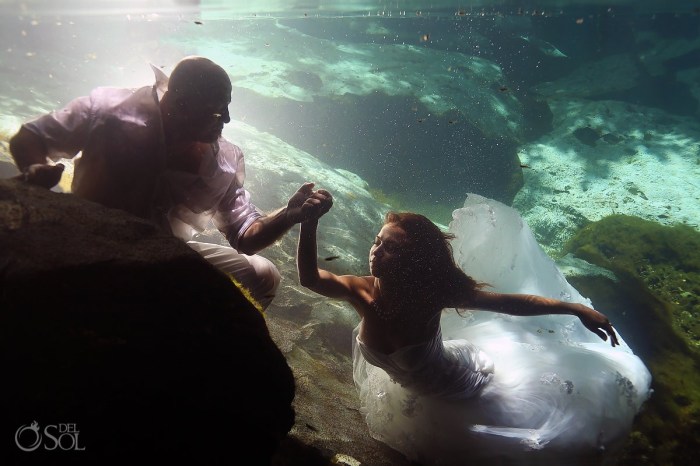Under Your Wedding Dress A Guide
The Tradition and Symbolism of Undergarments Worn Under Wedding Dresses: Under Your Wedding Dress
Under your wedding dress – The choice of undergarments for a wedding dress is often overlooked, yet it significantly impacts the overall look, feel, and even the symbolic meaning of the day. From historical corsetry to modern shapewear, the garments worn beneath the dress have evolved alongside societal norms and fashion trends, carrying with them layers of cultural and personal significance.
Historical and Cultural Significance of Undergarments
Historically, undergarments served practical purposes, primarily providing support and shaping the body to conform to the prevailing fashion ideals. In the Victorian era, for instance, corsets were essential for creating the desired silhouette, symbolizing both femininity and societal expectations of female form. These restrictive garments, while uncomfortable, were integral to the overall aesthetic of the time. Later periods saw a shift towards more comfortable and less restrictive undergarments, reflecting changing attitudes towards body image and comfort.
Evolution of Undergarments Across Eras
A timeline reveals the transformation of undergarments throughout history. From the restrictive corsets of the Victorian era to the more comfortable slips and petticoats of the 1920s and 1930s, and finally to the modern array of shapewear and seamless options, the evolution reflects both technological advancements and changing social norms. The 1950s saw the rise of petticoats and crinolines, creating full, voluminous skirts.
The 1960s and 70s brought simpler styles, often forgoing extensive undergarments altogether in favor of a more natural look.
Symbolism of Different Undergarment Types
Different undergarments carry varying symbolic weight. A corset, historically associated with constraint and societal expectations, can now represent a bride’s empowerment in embracing her body. A slip, on the other hand, often symbolizes elegance and simplicity. Shapewear, while focused on body shaping, can represent a bride’s confidence in presenting her best self. The symbolism is subjective and depends heavily on personal interpretation and cultural context.
Timeline of Undergarment Styles
A visual timeline would illustrate the progression: Victorian era (corsets), Edwardian era (corsets and camisoles), 1920s (slips and petticoats), 1950s (petticoats and crinolines), 1960s-70s (minimal undergarments), and present day (shapewear, seamless options).
Comfort and Practicality of Wedding Undergarments
While aesthetics play a crucial role, the comfort and practicality of undergarments are paramount on a bride’s wedding day. Choosing the right undergarments ensures a comfortable and stress-free experience, allowing her to fully enjoy the celebrations without discomfort or wardrobe malfunctions.
Factors to Consider When Selecting Undergarments
Several factors influence undergarment selection. The style and fabric of the wedding dress are key considerations. A lightweight silk gown may require minimal undergarments to avoid bulkiness, while a structured ballgown might benefit from supportive shapewear. The bride’s body type and personal preferences also play a significant role. The climate on the wedding day is another important factor; lightweight, breathable options are preferable in warmer weather.
Preventing Visible Lines or Seams

Source: weddingsonline.ie
Seamless undergarments are crucial for avoiding visible lines under the wedding dress. Choosing smooth fabrics and styles that lie flat against the body is essential. Seamless shapewear, specifically designed for this purpose, is a popular choice. Testing the undergarments with the dress beforehand is highly recommended to ensure a smooth and flawless look.
The Use of Shapewear
Shapewear can significantly alter the silhouette and create a smoother, more defined look under the dress. However, it’s important to choose shapewear that provides support without causing discomfort or restricting movement. Prioritizing breathable fabrics and a comfortable fit is crucial for all-day wear.
Impact on the Dress’s Silhouette
The choice of undergarments dramatically affects the overall look and drape of the wedding dress. Different undergarments can enhance or detract from the design, impacting the silhouette and the overall aesthetic.
Effect of Undergarments on Wedding Dress Silhouettes
A slip will create a smooth, flowing silhouette, particularly beneficial for A-line and ballgown styles. Shapewear, on the other hand, creates a more sculpted and defined look, ideal for fitted styles like mermaid or sheath dresses. The wrong choice can create unwanted bumps or distort the intended design.
Comparison of Undergarment Effects on Dress Styles
| Dress Style | Undergarment Type | Effect on Silhouette | Overall Look |
|---|---|---|---|
| A-line | Slip | Smooth, flowing | Elegant, classic |
| Mermaid | Shapewear | Sculpted, defined | Sleek, sophisticated |
| Ballgown | Crinoline/Petticoat | Full, voluminous | Romantic, dramatic |
| Sheath | Seamless bodysuit | Smooth, streamlined | Modern, minimalist |
Personal Style and Preferences in Undergarment Selection
Ultimately, the selection of undergarments is a personal choice. Comfort, body type, and personal beliefs all influence the decision-making process. A bride should prioritize comfort and confidence above all else.
Factors Influencing Personal Style Choices

Source: whiteonebridal.com
Factors like body type, personal comfort levels, and the overall style of the wedding play a crucial role. A bride might choose delicate lace lingerie to complement a bohemian dress, while another might opt for supportive shapewear to enhance a fitted gown. Personal beliefs about body image and self-expression also influence the choices.
Examples of Personal Style in Undergarment Choices

Source: delsolphotography.com
A bride with a curvy figure might opt for shapewear to create a smoother silhouette under a fitted dress, while a bride with a slender figure might choose a simple slip for comfort and elegance. A bride who prioritizes sustainability might select eco-friendly undergarments made from organic cotton or recycled materials.
Tips for Finding the Perfect Undergarments
- Consider the fabric and style of your wedding dress.
- Prioritize comfort and support.
- Choose seamless options to avoid visible lines.
- Try on undergarments with your dress before the wedding day.
- Consider your personal style and preferences.
Modern Trends and Innovations in Wedding Undergarments
The market for wedding undergarments is constantly evolving, with new innovations focusing on comfort, support, and sustainability. Seamless designs, innovative fabrics, and eco-friendly options are gaining popularity.
Current Trends and Innovative Designs
Seamless shapewear remains a popular choice, offering a smooth, invisible base layer. Lingerie with built-in support is also gaining traction, providing both comfort and a touch of elegance. The use of sustainable and ethically sourced materials is increasingly important for environmentally conscious brides.
Sustainability and Ethical Considerations
Many brides are now prioritizing sustainable and ethical undergarments. This includes choosing brands that use organic cotton, recycled materials, or fair-trade practices. This reflects a growing awareness of the environmental and social impact of fashion choices.
Modern Undergarment Options
- Seamless shapewear for fitted dresses
- Supportive slips for A-line and ballgown styles
- Delicate lace lingerie for bohemian dresses
- Breathable cotton options for warmer climates
- Eco-friendly and ethically sourced undergarments
Visual Representations of Undergarments and Dress Silhouettes
Visualizing the effect of undergarments on different dress styles helps brides make informed choices. The following descriptions illustrate how different undergarments impact the overall look and feel of the wedding ensemble.
Classic A-line Dress with Supportive Slip
A bride wearing a classic A-line wedding dress with a supportive slip will present a graceful, flowing silhouette. The slip creates a smooth base layer, enhancing the natural drape of the dress without adding unnecessary bulk. The overall look is elegant and timeless, emphasizing the dress’s inherent beauty.
Fitted Mermaid Gown with Shapewear, Under your wedding dress
A bride in a fitted mermaid gown paired with shapewear will exhibit a sculpted, hourglass figure. The shapewear enhances the dress’s form-fitting design, creating a sleek and sophisticated look. The body appears more defined and streamlined, emphasizing the dress’s curves and highlighting the bride’s figure.
Bohemian Dress with Delicate Lace Lingerie
A bride in a bohemian-style wedding dress with delicate lace lingerie will exude a romantic and ethereal aura. The lace adds a touch of femininity and visual interest, subtly peeking through the sheer or loosely woven fabric of the dress. The overall aesthetic is effortlessly chic and reflects a relaxed, free-spirited style.
Expert Answers
What if my dress is a delicate lace?
Opt for seamless, nude-colored shapewear or a whisper-thin slip to avoid showing lines or bulk under the lace.
How do I prevent visible panty lines?
Choose seamless, laser-cut underwear or consider a thong or boy shorts designed for invisibility under fitted clothing.
Should I wear a bra under my wedding dress?
It depends on the dress style and your personal preference. Some dresses have built-in support, while others may require a strapless or adhesive bra for lift and support.
What if I’m uncomfortable with shapewear?
Consider a well-fitting slip or supportive undergarments that provide comfort without excessive compression. Prioritize comfort above all else.



















